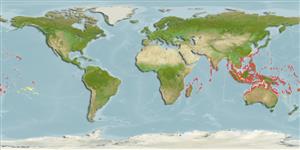Common names from other countries
>
Eupercaria/misc (Various families in series Eupercaria) >
Lethrinidae (Emperors or scavengers) > Monotaxinae
Etymology: Gnathodentex: Greek, gnathos = jaw + latin, dens, dentis = teeth (Ref. 45335).
More on author: Lacepède.
Environment: milieu / climate zone / depth range / distribution range
экология
морской ассоциированный с рифами; немигрирующий; пределы глубины 0 - 30 m (Ref. 9710). Tropical; 30°N - 30°S, 31°E - 134°W
Indo-Pacific: East Africa to the Tuamoto Islands (excluding the Hawaiian Islands), north to Japan, south to Australia. Recently reported from Norfolk Island (Ref. 8880).
Size / Вес / Возраст
Maturity: Lm ? range ? - ? cm
Max length : 42.3 cm FL самец/пол неопределен; (Ref. 125599); common length : 20.0 cm TL самец/пол неопределен; (Ref. 2295); наибольший вес (опубликованные данные): 2.1 kg (Ref. 125599)
колючие лучи спинного плавника (общее число) : 10; членистые (мягкие) лучи спинного плавника (общее число) : 10; колючие лучи анального плавника: 3; членистые (мягкие) лучи анального плавника: 8 - 10.
Inhabits subtidal reef flats, lagoons, and seaward reefs (Ref. 9710). May be solitary or in groups (Ref. 90102). Sometimes forms aggregations of about a hundred or more individuals. Feeds at night on benthic invertebrates like crabs and gastropods, occasionally on small fish. Usually marketed fresh. Minimum depth reported taken from Ref. 128797.
Life cycle and mating behavior
Maturities | размножение | Spawnings | Egg(s) | Fecundities | личинки
Carpenter, K.E. and G.R. Allen, 1989. FAO Species Catalogue. Vol. 9. Emperor fishes and large-eye breams of the world (family Lethrinidae). An annotated and illustrated catalogue of lethrinid species known to date. FAO Fish. Synop. 125(9):118 p. Rome: FAO. (Ref. 2295)
Статус Красного Списка МСОП (Ref. 130435)
CITES (Ref. 128078)
Not Evaluated
Угроза для людей
Reports of ciguatera poisoning (Ref. 4690)
Использование человеком
рыболовство: коммерческий
дополнительная информация
инструменты
Специальные отчеты
Скачать в формате XML
ресурсы в Интернет
Estimates based on models
Preferred temperature (Ref.
115969): 24.9 - 29.3, mean 28.4 (based on 3356 cells).
Phylogenetic diversity index (Ref.
82804): PD
50 = 1.0000 [Uniqueness, from 0.5 = low to 2.0 = high].
Bayesian length-weight: a=0.01585 (0.00973 - 0.02580), b=3.01 (2.87 - 3.15), in cm Total Length, based on LWR estimates for this species & (Sub)family-body (Ref.
93245).
Trophic level (Ref.
69278): 3.7 ±0.57 se; based on food items.
устойчивость к внешним воздействиям (Ref.
120179): средний (среднего размера), минимальное время удвоения популяции 1.4-4.4 года (Preliminary K or Fecundity.).
Fishing Vulnerability (Ref.
59153): Moderate vulnerability (37 of 100).
